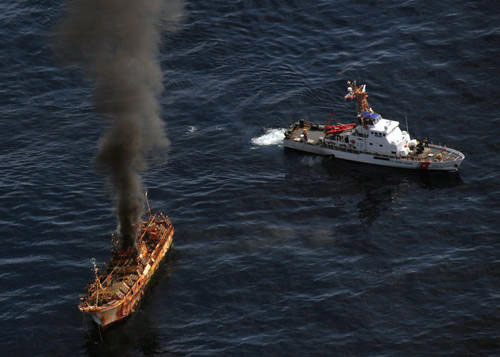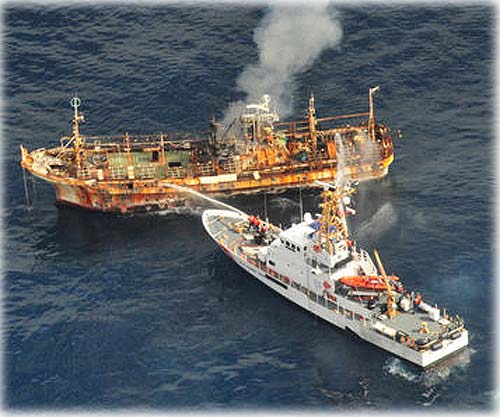
Ghost Ship Ryou-Un Maru Scuttled
April 06, 2012
The Coast Guard went ahead with plans to sink the vessel after a Canadian company that was going to salvage the vessel decided not. The Anacapa crew began its operation to sink the vessel at approximately 1 p.m. Thursday and completed two gunnery evolutions shooting highly explosive ammunition into the vessel until it sank in 6,072 feet of water.
The Japanese fishing vessel Ryou-Un Maru burns after the Coast Guard Cutter Anacapa crew fired explosive ammunition at the vessel 180 miles west of the Southeast Alaskan coast April 5, 2012.
U.S. Senator Mark Begich (D-Alaska) said in a prepared statement, “I support the Coast Guard’s decision to sink the tsunami ghost ship as a threat to navigation. We can neither let this abandoned vessel drift freely amidst the shipping lanes off Sitka, nor can we allow it to become shipwrecked along the coastline of Alaska." Begich said, “Having been written off by its Japanese owner and now a Canadian salvage interest, and no responsibility party to assume the expense, I don’t want the American taxpayer to foot the bill or Alaskans to clean up the mess." “I recommended last year the renegade pirate ship be sunk, so I am glad to see the Coast Guard moving forward on my suggestion to sink the Japanese vessel, said Begich. Begich said he was confident Thursday’s action will have a minimal environmental impact, if at all. NOAA officials say any fuel on board will be quickly dispersed on the high seas. And any debris that hasn’t already been stripped from the vessel is minimal compared to the millions of tons of debris swept out of sea by last year’s tsunami and has either sunk or is still headed toward our beaches.
The Coast Guard Cutter Anacapa crew douses the adrift Japanese vessel with water after a gunnery exercise 180 miles west of the Southeast Alaskan coast April 5, 2012. The crew was successful and sank the vessel at 6:15 p.m. in 6,000 feet of water by using explosive ammunition and filling it with water.
“Last year’s disastrous earthquake and tsunami devastated Northern Japan, claimed tens of thousands of lives, and created a debris problem which we will deal with for years to come. Further research may offer better alternatives but absent any acceptable option for the American taxpayer, the Coast Guard was right to take decisive action today to remove this twice-abandoned vessel as a hazard to navigation,” Begich added. The Coast Guard worked closely with federal, state and local agencies to assess the immediate dangers the vessel presented and determined that sinking the vessel at sea would be the best course of action to help minimize any navigation and environmental threats. Light sheening and minimal debris have been reported from the sinking of the vessel, and the sheening is expected to quickly dissipate at sea.
Edited by Mary Kauffman, SitNews
Sources of News:
E-mail your news &
photos to editor@sitnews.us
|
||

